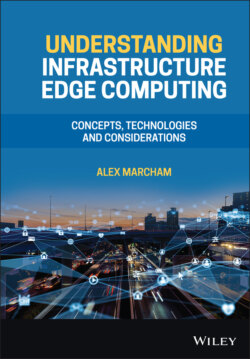Читать книгу Understanding Infrastructure Edge Computing - Alex Marcham - Страница 17
2.3.1 A Tale of Many Edges
ОглавлениеAlthough there are many potential edges, for the purposes of this book and to the most general definition of edge computing, the edge that is of the greatest importance is the last mile network.
The last mile network is the clearest point of physical separation between end user devices and the data centre infrastructure which supports them. In this context, the last mile network refers to the transmission medium and communications equipment which connects a user device to the network of a network operator who is providing wide area network (WAN) or metropolitan area network (MAN) service to one or more user devices, whether large or small, fixed position or mobile.
Examples of last mile networks include cellular networks, where the transmission medium is radio spectrum and the communications equipment used includes radio transceiver equipment, towers, and antennas. Wired networks such as those using cable, fibre, or digital subscriber line (DSL) are also examples of last mile networks which use a copper or fibre‐based transmission medium. The specific type of last mile network used is irrelevant here for the terminology of edge computing.
This definition cannot capture all of the potential nuance which may exist; for example, in the case of an on‐premises data centre which is physically located on the device side of the last mile network, the owner of that data centre may regard it as infrastructure rather than as a device itself. However, a different definition and accompanying set of terminology offering equal clarity without introducing unnecessary dimensions into the equation has not been established within the industry, and so this book will continue to use the infrastructure edge and device edge, separated by a last mile network.
Fundamentally, if everything can be recast as an example of edge computing, then nothing is truly an example of edge computing. It is similar to referring to a horse and cart as a car because both of them consist of a place to sit, four wheels, and an entity that pulls the cart forward. This is important to note with both the infrastructure edge and the device edge. In the case of the former, an existing data centre which exists a significant distance away from its end users should not be referred to as an example of edge computing. If, however, that same data centre is located within an acceptable distance from its end users and it satisfies their needs, an argument can be made for it to be so.
Similarly, if a device edge entity, such as a smartphone which already had significant local compute capabilities is now referred to as an edge computing device yet does not participate in any device‐to‐device ad hoc resource allocation and utilisation, this is a somewhat disingenuous application of the term edge computing. However, where there was once a dumb device or no device at all which is now being augmented or replaced with some local compute, storage, and network resources, this can be reasonably argued to be an example of device edge computing, even if limited in capability.
Although “edge washing” of this type is not unique to edge computing as similar processes occur for most technological changes for a period of time, due to the difficulties previously mentioned in the industry arriving at a single set of terminology around edge computing, this can be challenging to identify. This identification challenge can be addressed by using the framework described in the next section.
